Brinyte T18 review
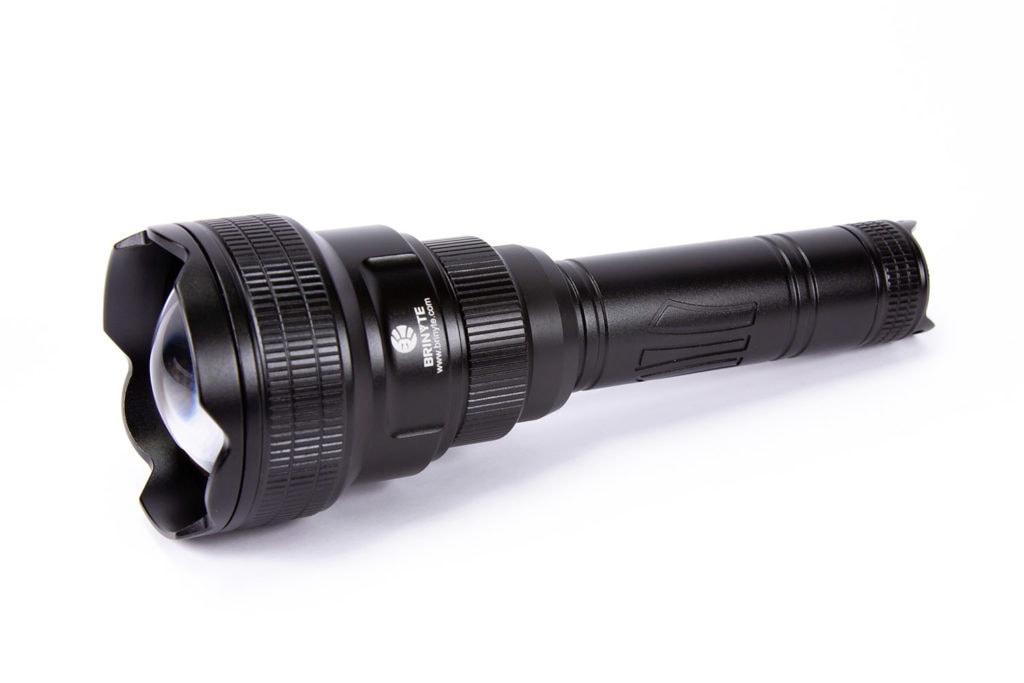
Brinyte T18 Specifications
| Brand / Model | Brinyte T18 Artemis |
|---|---|
| LED | Six different unspecified emitters |
| Lumens | 650 lumens (white, flood) |
| Beam intensity | 100 kcd+ |
| Battery config. | 1*21700 |
| Material | Aluminum |
| Modes | 1 |
| Blinkies | N/A |
| Reflector | Aspheric optic |
| Waterproof | IP66 |
| Review date | September 2020 |
INTRODUCTION:
Before I start this review, I just need to get something off my chest:
I…. I quite like zoomies.
There, I said it. I hope you’re all happy that you’ve pushed me into this confession – I know this is somewhat sacrilegious within the enthusiast community, but it needed to be said. I’ll go find my flame-proof suit now, if you don’t mind.
——————
Brinyte has been in the flashlight business since 2006 from both an R&D and manufacturing standpoint; while I haven’t been aware of them until fairly recently, that’s more to me not being the target audience for most of their lights. As such, I haven’t used any of Brinyte’s lights before; I have however have seen them mentioned around the community, as well as having read Gabe’s PT18Pro and PT28 reviews.
As the T18 is primarily marketed as a hunting light, this review will cause a slight issue for me, as I’m not a hunter, nor own any guns/weapons. As such, please take my opinions with a grain of salt; I’ve done some reading as to how the colours can be useful with hunting, but I don’t have first-hand experience so my knowledge is limited in that regard. As such, I’ll cover the different emitters on their own merits.
Onwards!
Package quality.
I received the T18 well-packed – a blank cardboard box (save for a small “699” written in the upper left corner), inside a cardboard roll, inside another cardboard box.
Inside the “699” box, however, I find:
- The T18 Artemis itself – bubble-wrapped, and with a “baggie” over the head to protect the lens from dust/scratches
- Brinyte-branded 5000mAh 21700 cell with isolation cover/tab
- “White” emitter pill installed
- Lanyard attached, looped together with the lanyard for the:
- Remote
- attached is the aforementioned lanyard
- 5 other pills in individual containers (green, red, blue, UV, IR850)
- Additional pills will be dependent on which kit you have purchased
- USB A-C cable for battery (90cm)
- MicroUSB cable for remote (15cm)
- 3x O-rings
- Manual
There’s seven different configurations of emitters that are available when purchasing the T18:
- White/Red/Green
- White/Red/IR850
- White/Green/IR850
- Red/Green/IR850
- Blue/UV/IR
- White/Red/Green/UV/IR850
- White/Red/Green/UV/IR850/Blue
An interesting thing about the manual is that it’s separate cards, held through a punch-hole in the upper left corner by a short lanyard.
As per the image, there was a foam layer on top; this kept all the components together quite nicely.
The other item in the box was a lovely handwritten note from Kitty at Brinyte, expressing her wishes that I enjoy the light. It’s a nice personal touch, and I definitely appreciate the thought.
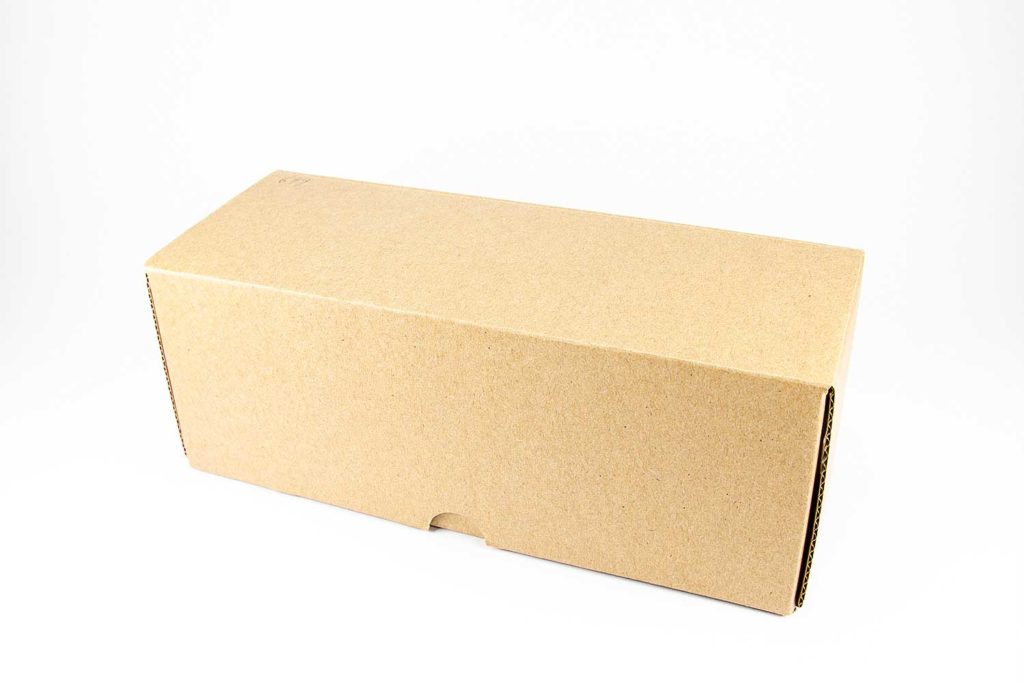
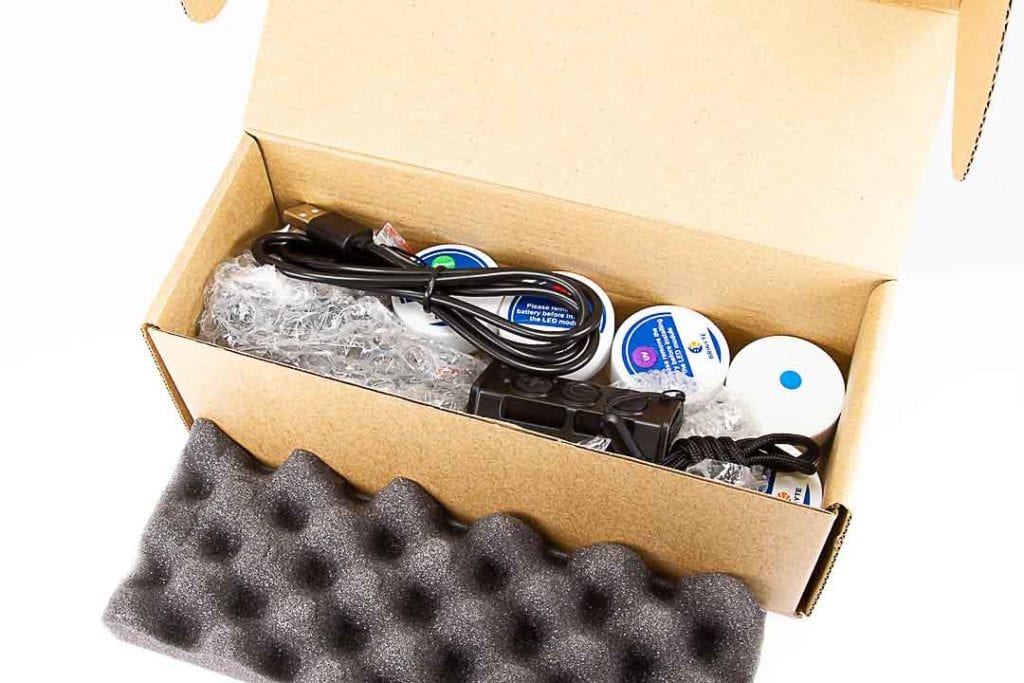
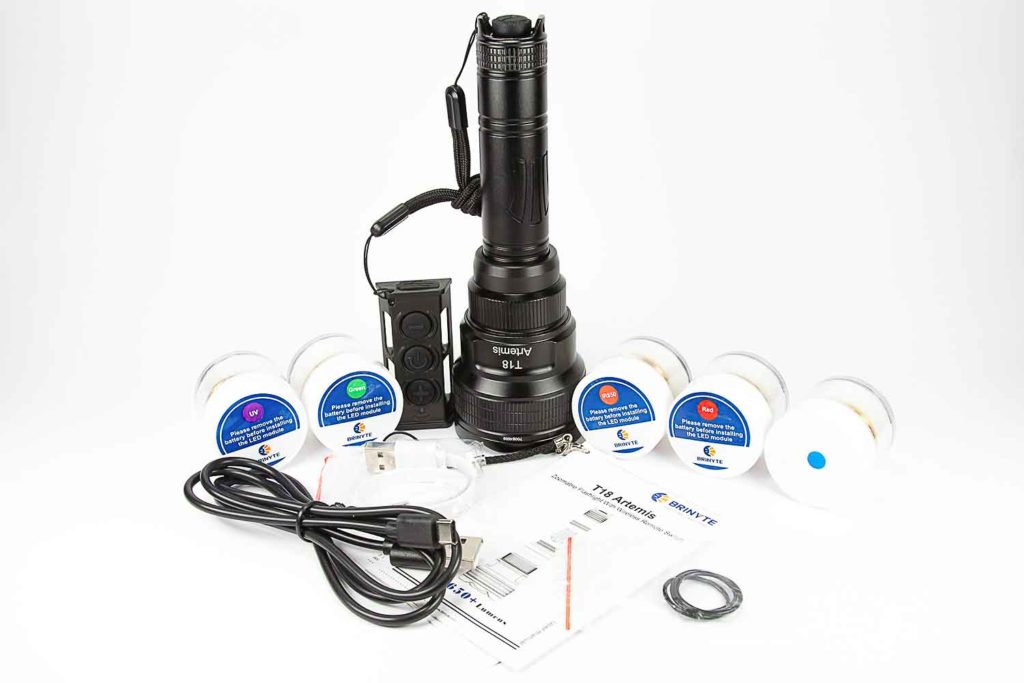
Handling of the light
For all its size, the T18 Artemis is really quite a svelte light. Even through all the changes in size from tail to head, it has a very smooth feel to it that I haven’t often encountered. There are markings and knurlings, but they all give way to the large patches of unadulterated smooth anodisation.
You can hold the light in either an underhanded method or in the “tactical” position – either position is comfortable, but the tactical position may become uncomfortable fairly rapidly due to the weight of the light (while not onerous, still decent).
Rotating the head in and out of throw and flood mode is a fairly smooth experience. There’s a brief hitch when taking it from flood to throw, but it’s a very slight grab and requires almost no extra force to go past.
There’s a forward-clicky switch to enable momentary-on, which is definitely something I can imagine being useful for hunting.
As there’s no hard edges on the light, if this is put down on an incline, it’s going rolling. The best way to secure it would be in a dedicated pocket or holster, to keep it safe and secure.
The remote is described as having a range of 5m – I’ve tested it out by slowly moving further away from the light and activating it, and it seems to still work at around 13m line-of-sight. I realise that this isn’t the only way people will use it though, so 5m with things between the remote and the light is perfectly reasonable.
You can tailstand the T18 if you really want to, but it’s not overly stable – the flat areas that would be touching the ground/surface only account for ~25% of the circumference, along with the light being top-heavy.
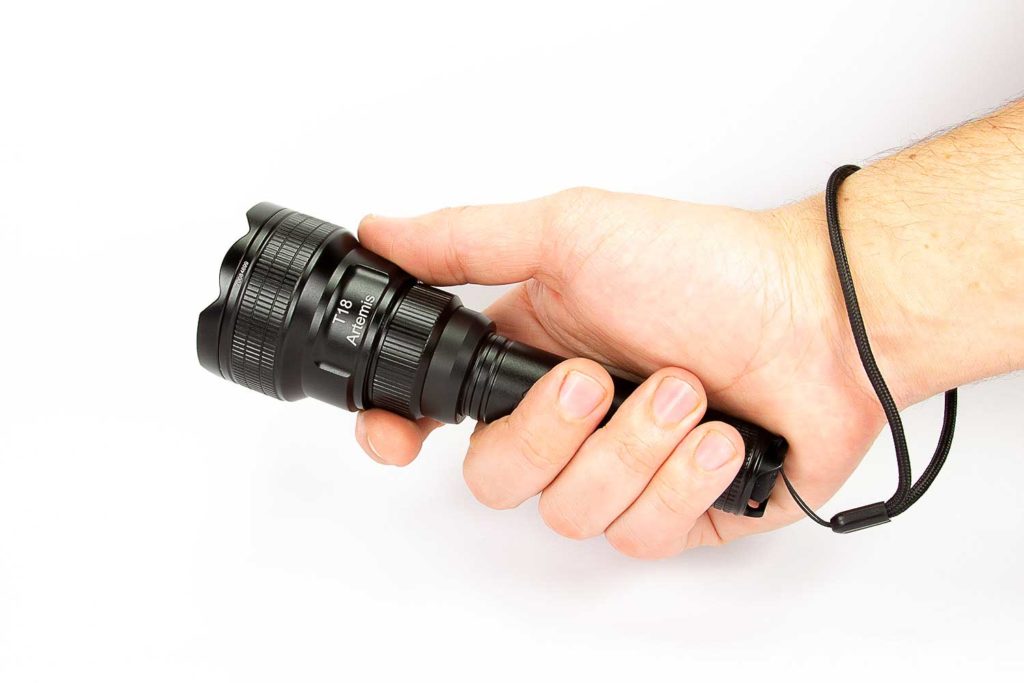
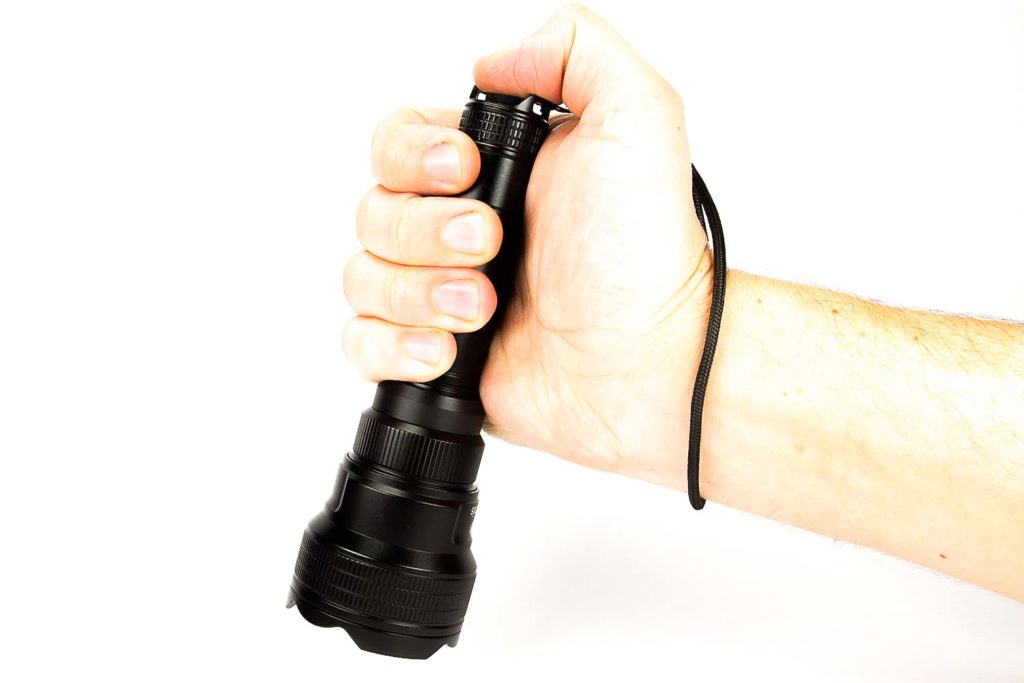
Build Quality, Knurling, Threads, and anodization
This is a very solid light. The anodisation is satin smooth, and as mentioned, there’s not a sharp area I can detect at all. There’s light milling on the battery tube with a logo that seems to be an elongated version of the lightbeams in the Brinyte logo.
Knurling on the light is minimal, and left to the areas that require the most attention. The tailcap, head, and the underside of the head have texture, but none of it is particularly aggressive. That’s perfectly fine though, as there’s a lot of movement needed to rotate the head between flood and throw, and the last thing I would want is to be tearing my hands up while doing so.
The first bump in width above the battery tube is actually a plastic – this has the antennae for the remote behind it though, so it needs to be that way. There’s a slight colour mismatch, but that’d be extremely difficult to rectify, I can imagine.
There’s three o-rings that I could locate on this light – one sits snugly between the body tube and the tailcap, another is between the optic and the bezel, and the last one sits where the head detaches from the tube to replace the emitter pill. While lights with moving parts are inherently less water-resistant than solid-state lights, this is quite a good effort from Brinyte, covering the majority of ingress areas. The IP66 rating doesn’t cover immersion in water, but would definitely cover a solid rainstorm if it were subject to that.
The threads on the tailcap are a reverse from what I’d usually see; I’m used to seeing the threads being prominent from the body tube, with the tailcap going over the top, but on the T18, it’s the other way around. The threads aren’t anodised, so if you have the switch activated, as soon as there’s contact with the cell and body tube, the light will engage. This means there’s no lockout via twisting the tailcap slightly. I’d prefer to see a more traditional thread setup here, with anodised threads to assist with lockout, but it’s not that jarring.
The lanyards included on the light and the remote are fairly average and barely fit over my hands, but that’s not an issue. I’d hazard a guess that the lanyards wouldn’t be used much if ever, and the remote has double-sided velcro tape to secure it to a hard surface.
The remote itself is also quite sturdy, and has a small flap over the Micro-USB port for charging. I’m fairly confident that this remote could fall quite a long way before suffering any real damage.

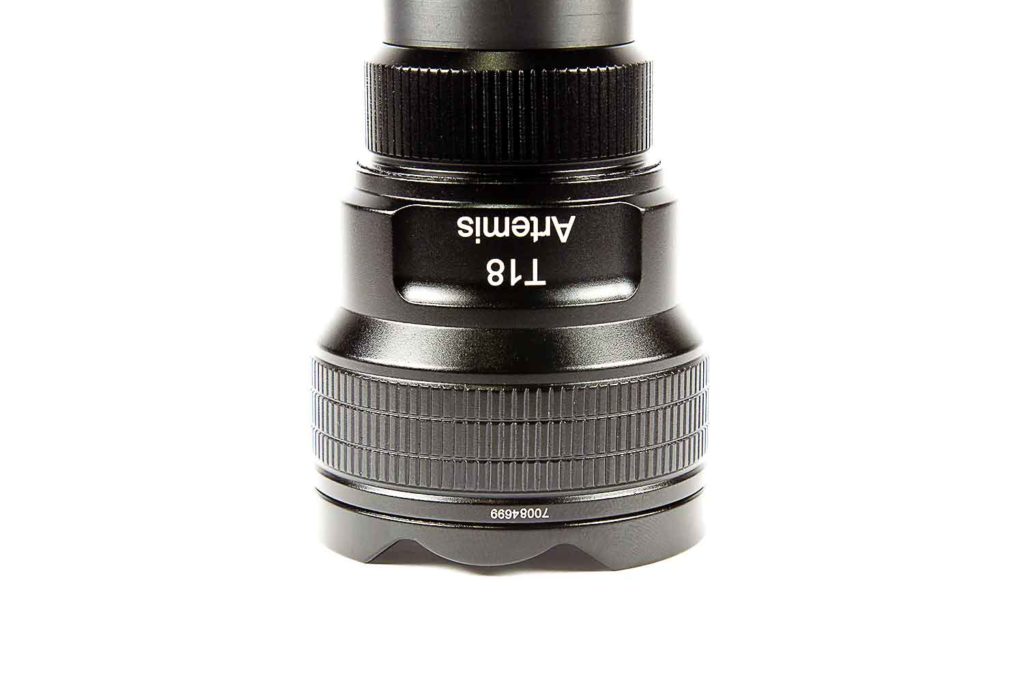
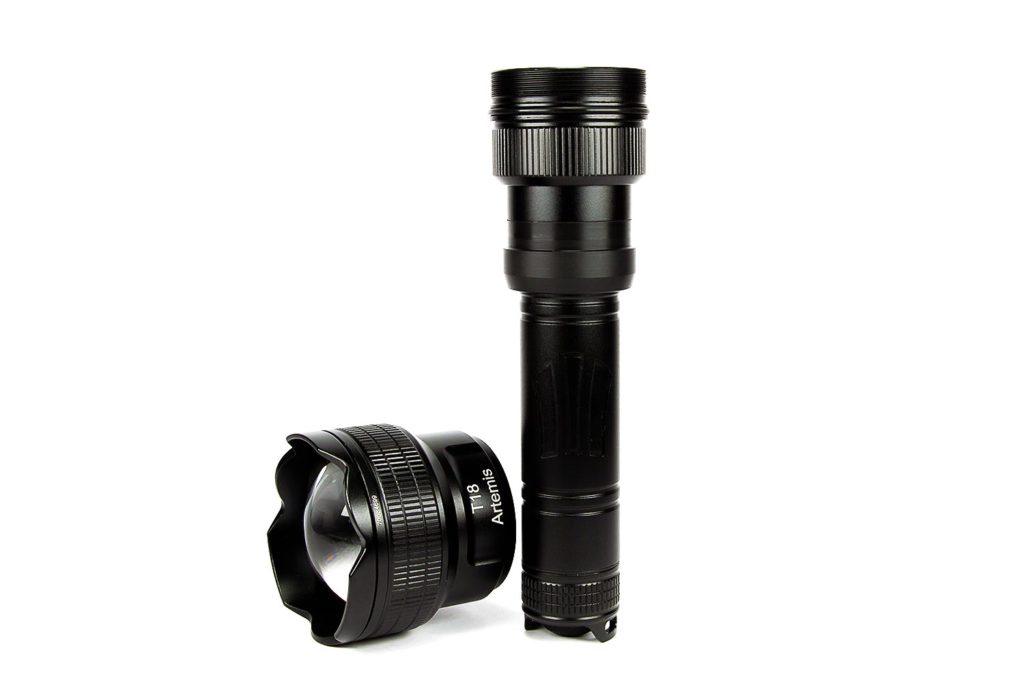
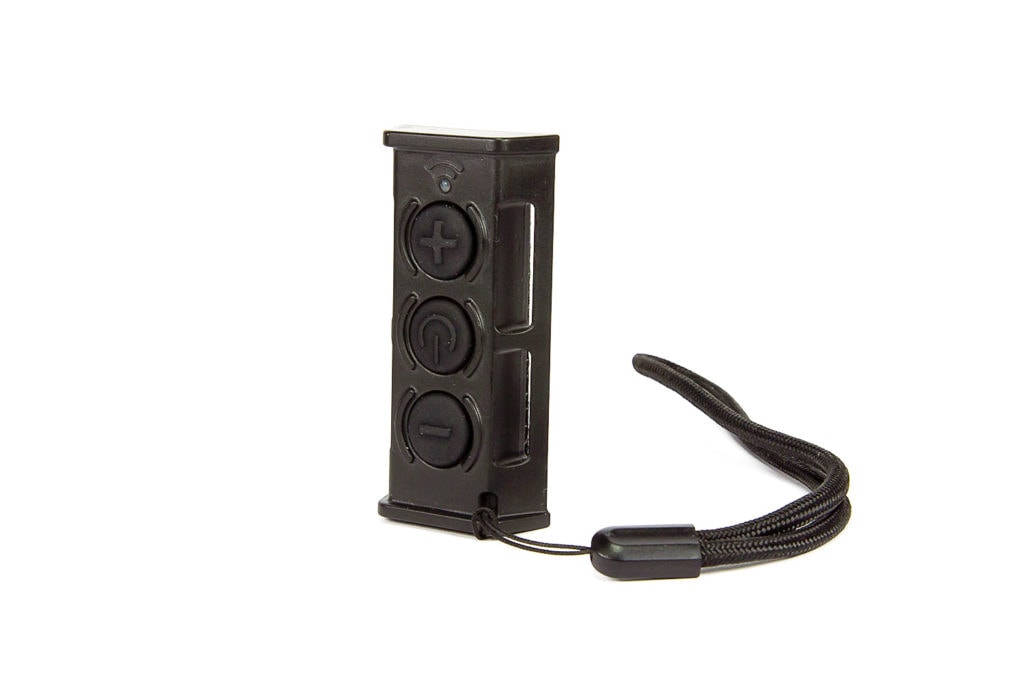
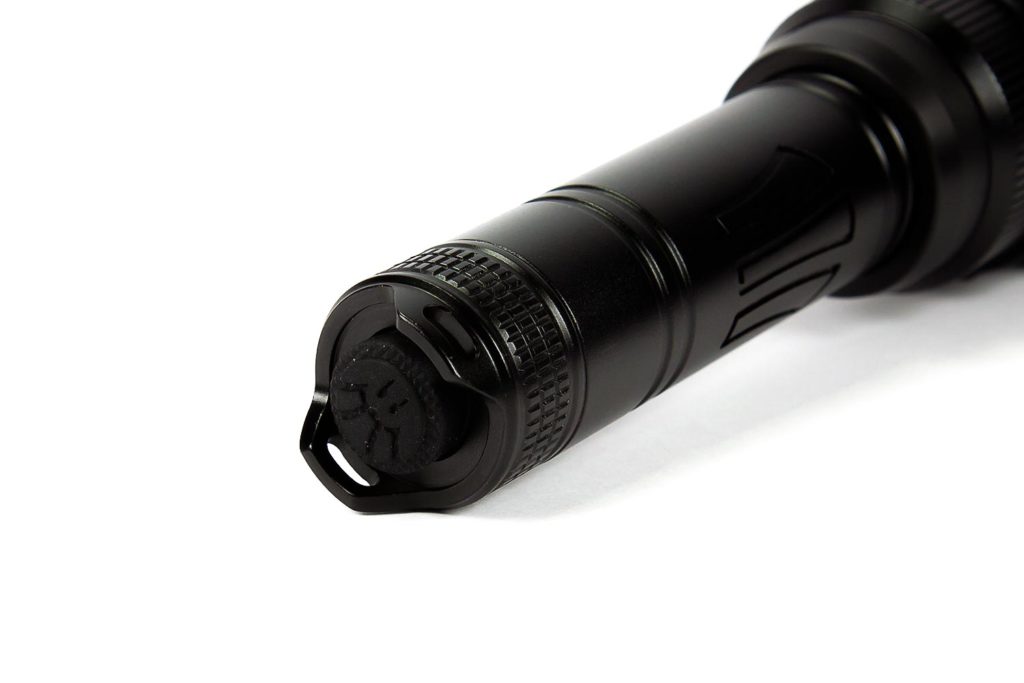
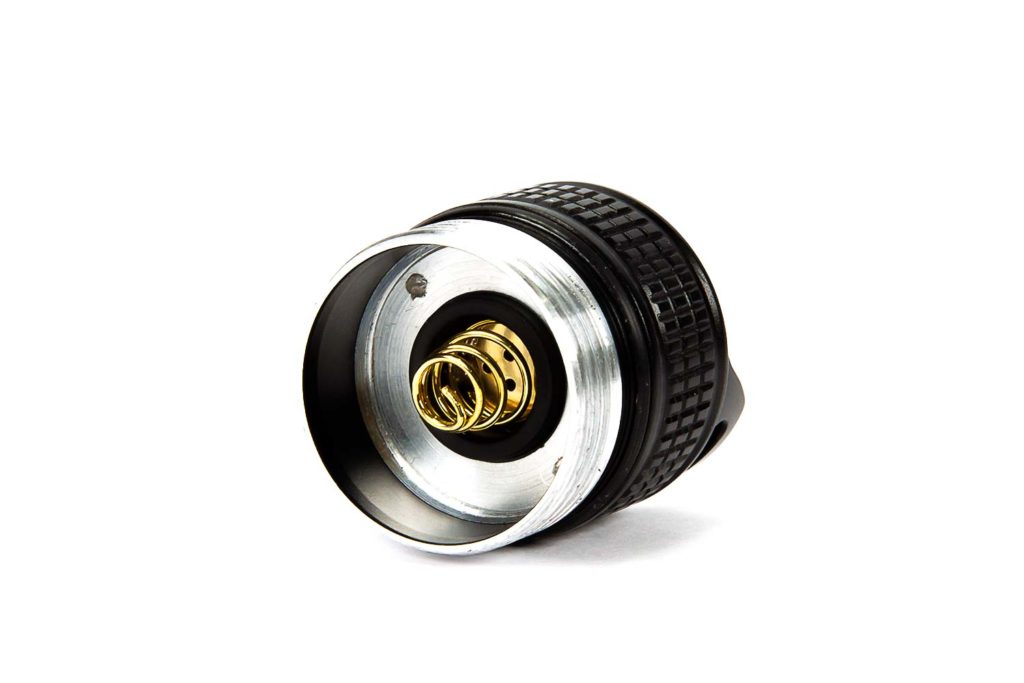
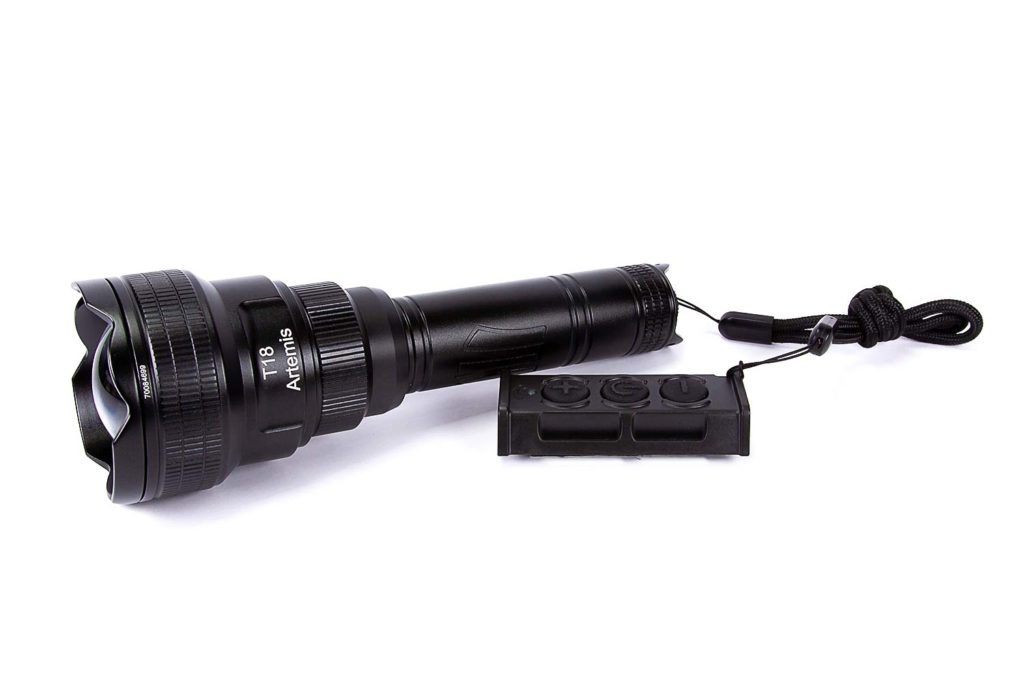
LED, LENS, BEZEL, AND REFLECTOR
So here’s where it gets somewhat interesting. Given that there’s six emitters in this kit, I’ll write a little about each of them. Each emitter comes in a pill that can be swapped out; I initially made the mistake of unscrewing the bezel and removing the lens each time I swapped it, but by far the easiest way to do it is to unwind the light to “full throw” mode, and keep turning it in that direction. The whole head section will detach, then you wind the collar back to fully expose the pill, and not destroy your fingertips in the process.
I’ve heard rumours that if you read the manual a light comes with, you know how to do things properly, but I’m far too impulsive for sensible things like that.
Another thing to note is that the pills are closer to brass than copper, as described, but that’s not an issue. If they are actually pure copper though, I’ll eat my words along with some humble pie.
I’ll outline the various emitters that are available, and a few notes after each, if necessary. Hunters out there will know significantly more than I about the coloured lights, so I won’t pretend to know the relevance of each of these to hunting.
The emitters:
White: The white emitter is a Cree XP-L HI – my best guess on CCT is 6000-6500K, but I feel it’s closer to 6000K. Definitely a good choice for this light, as being factory de-domed means that at maximum range, it’s going to throw quite well. A slightly lower CCT may have been a bit nicer, but it’s not a horribly cool white.
Red: XP-E2 Red. A good solid red, and in my estimation, about 620nm.
Green: XP-E2 Green. I’m unsure what wavelength this is, actually, as I don’t really have an eye for greens, but it’s a very strong colour.
Blue: XP-E Blue. It’s a nice deep blue that definitely helps colour differences pop.
UV: I’ve got a pretty good hunch that this is the LG LEUVA33W70RL00 – this is the higher-current UV emitter that was previously quite difficult to get, but appears to be making it into more lights now. It’s capable of 5W, so that’s a decent chunk of power that can be pushed into it.
IR850: I… I have no idea where to start with this. I think it’s an Osram Olson Black SFH 4715A, but I can’t be sure. I don’t have any photographic equipment that can actually see this beam, so I’m at somewhat of a loss!
The bezel has six distinct crenelations, three of which are more pronounced than the others. None of them are sharp though, which is lovely! It comes across as a more organic shape, as the smaller crenelations are a simple curve, which fits in thematically well with the lens.
As with all zoomies, there’s an aspheric lens used, and it’s decently convex. It’s made of a high transmittance resin, which I initially mistook for glass when first looking at it because it was so clear.
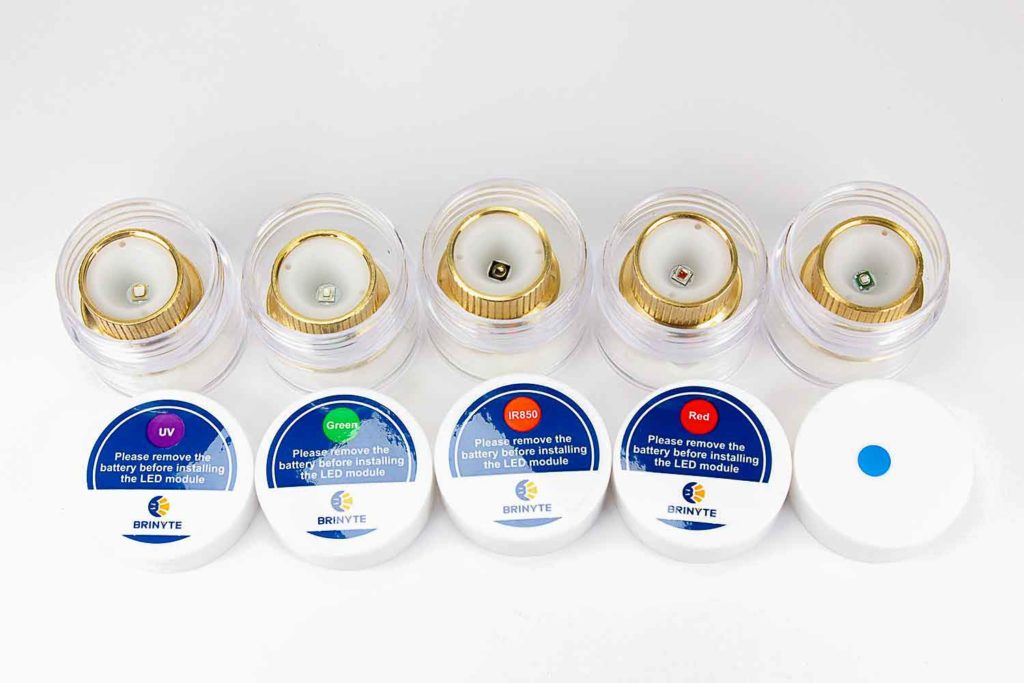
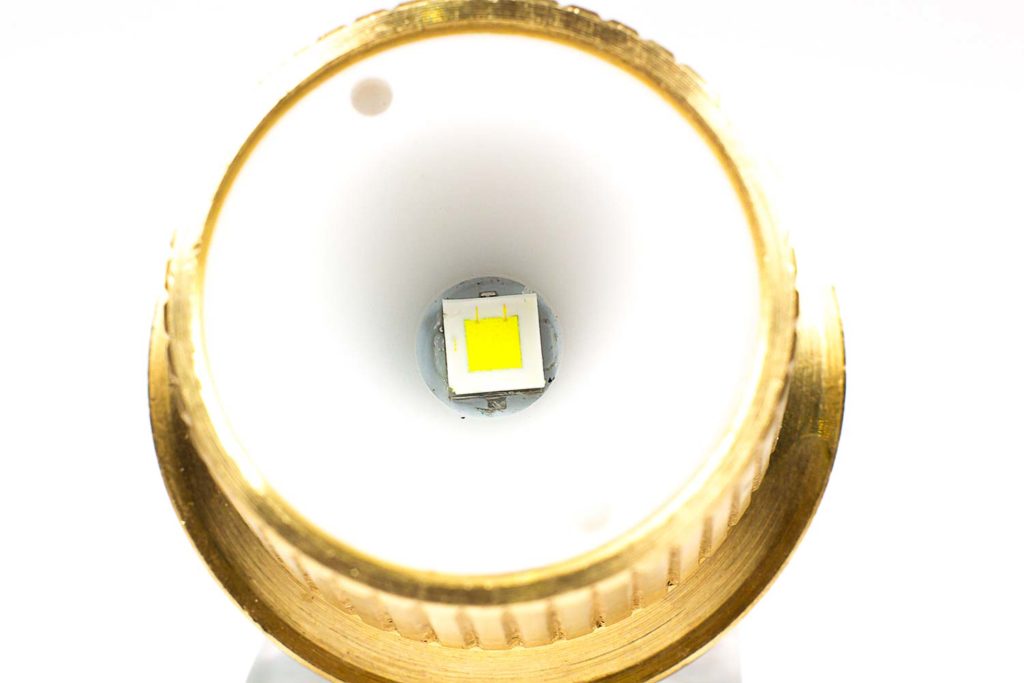
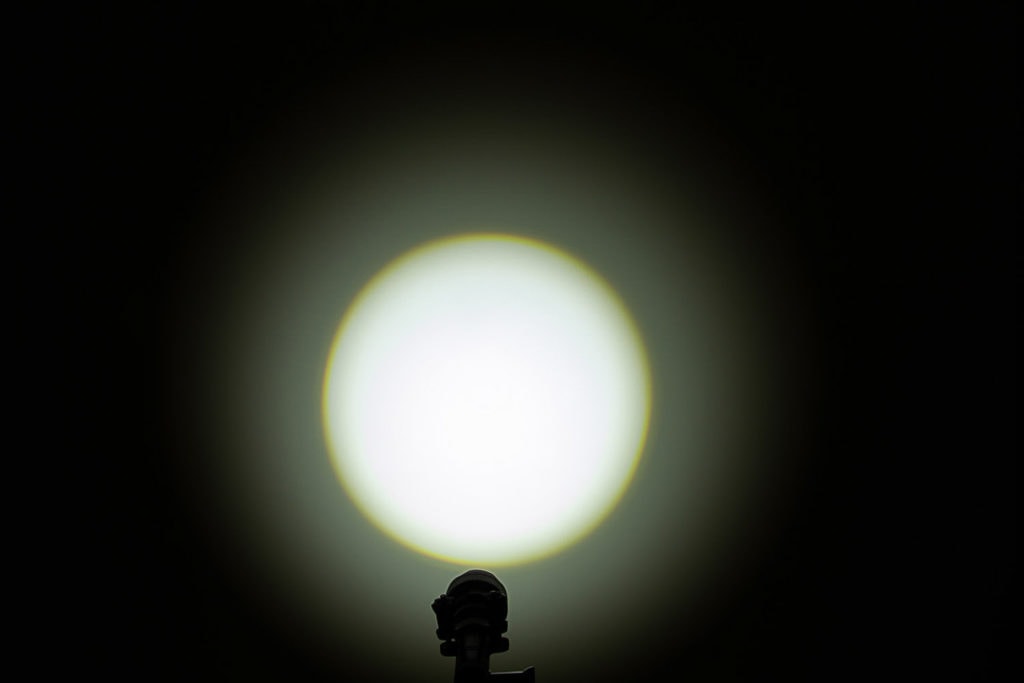
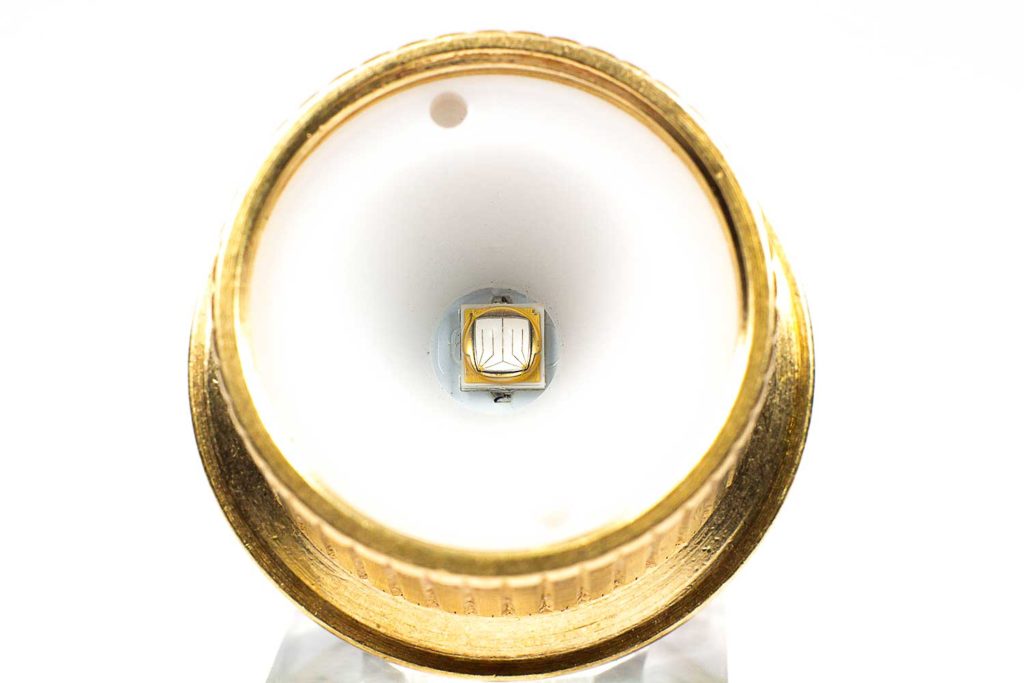
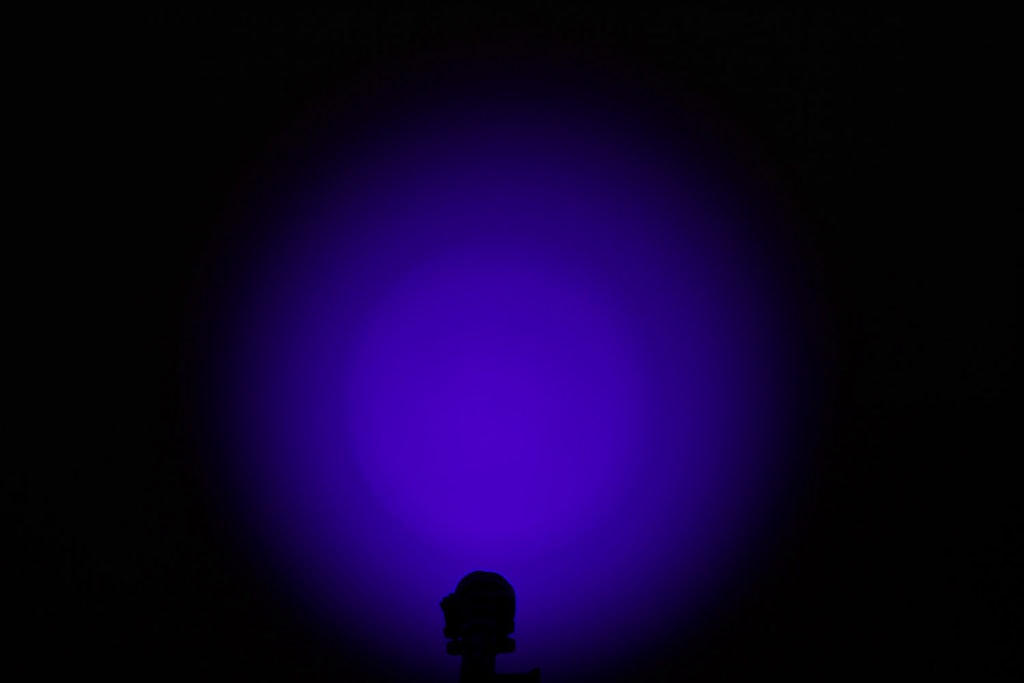
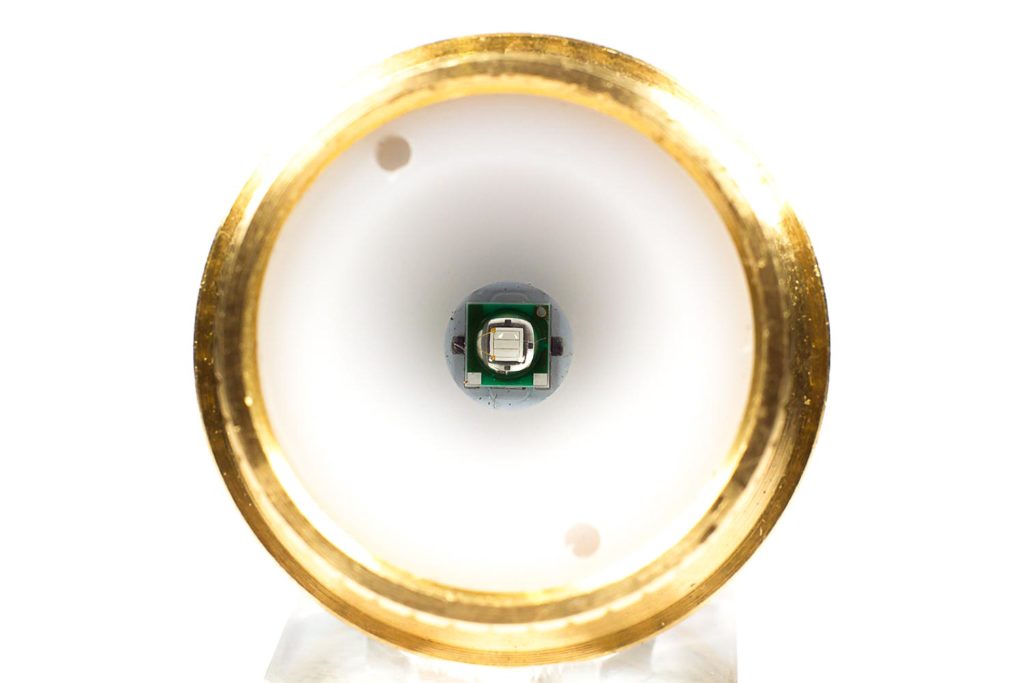
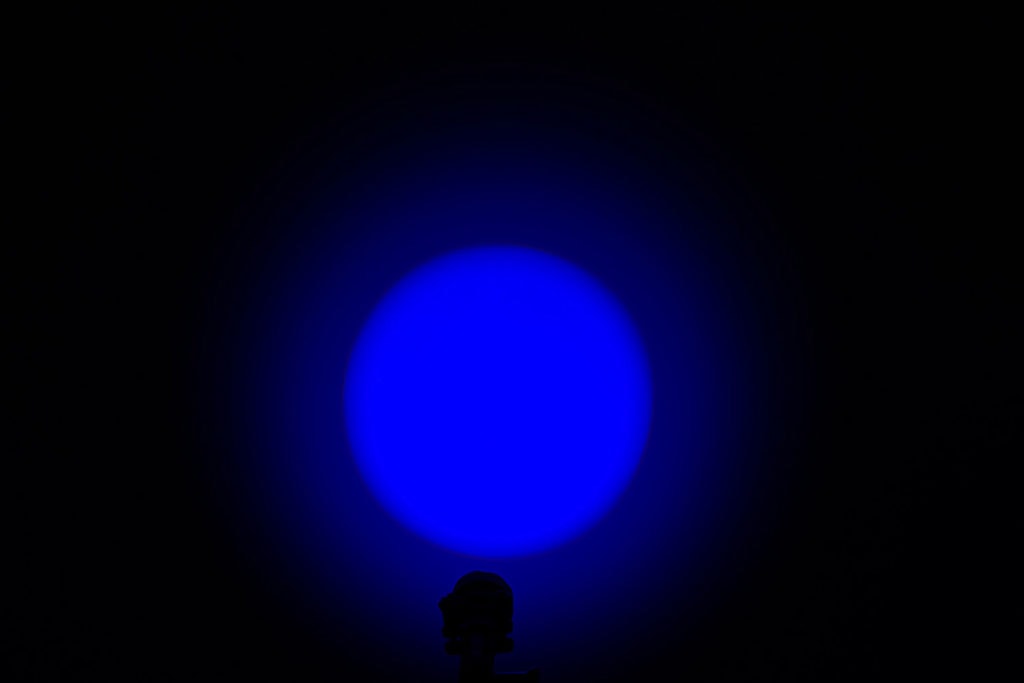
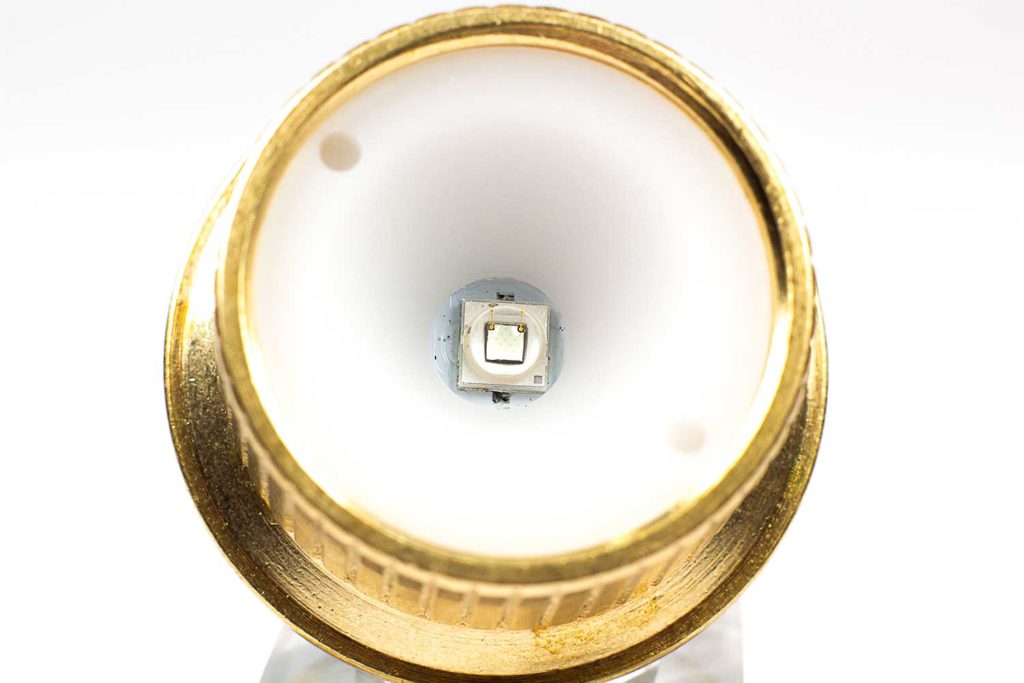
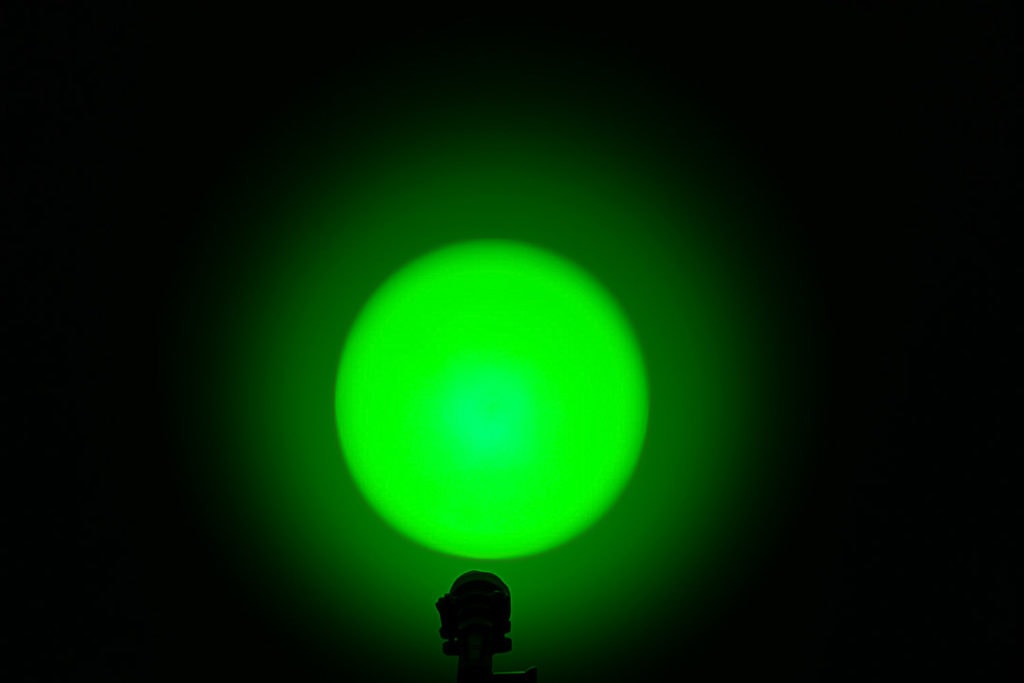
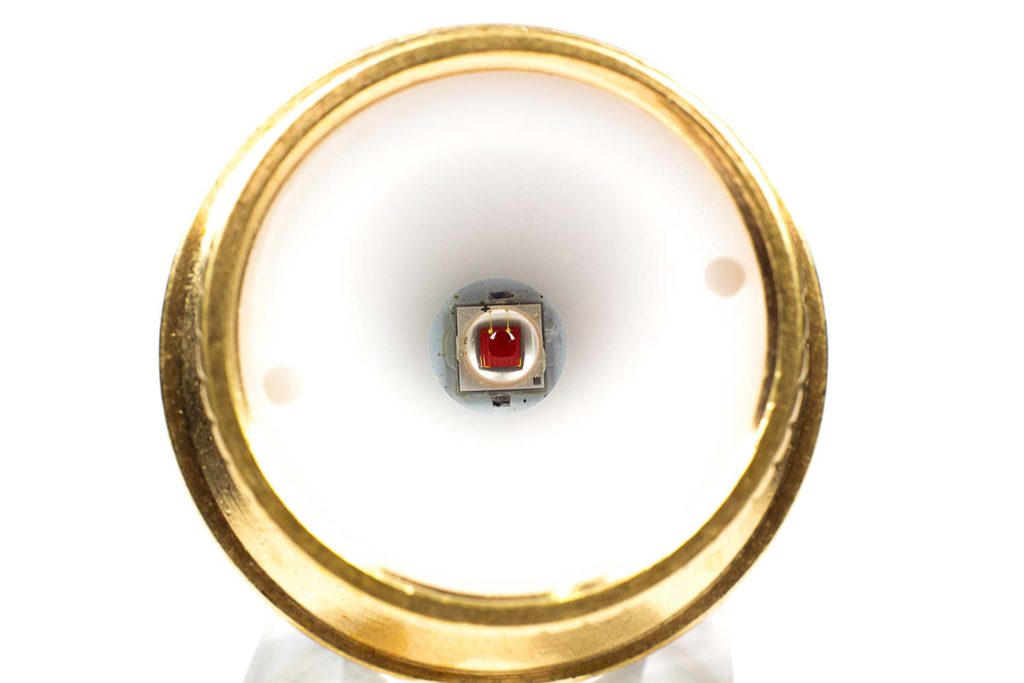
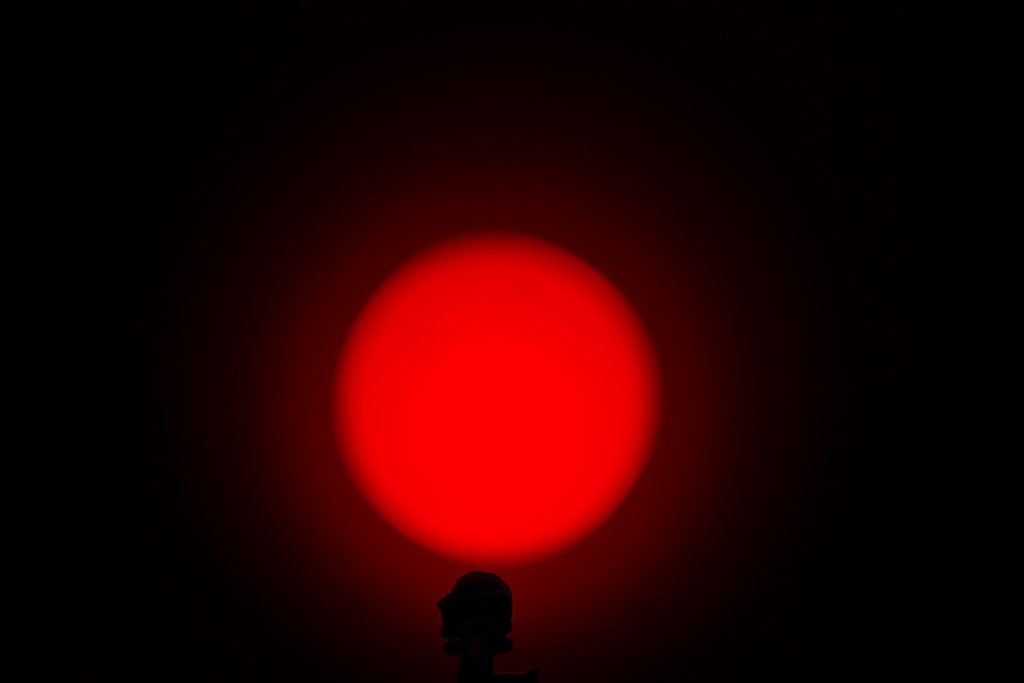
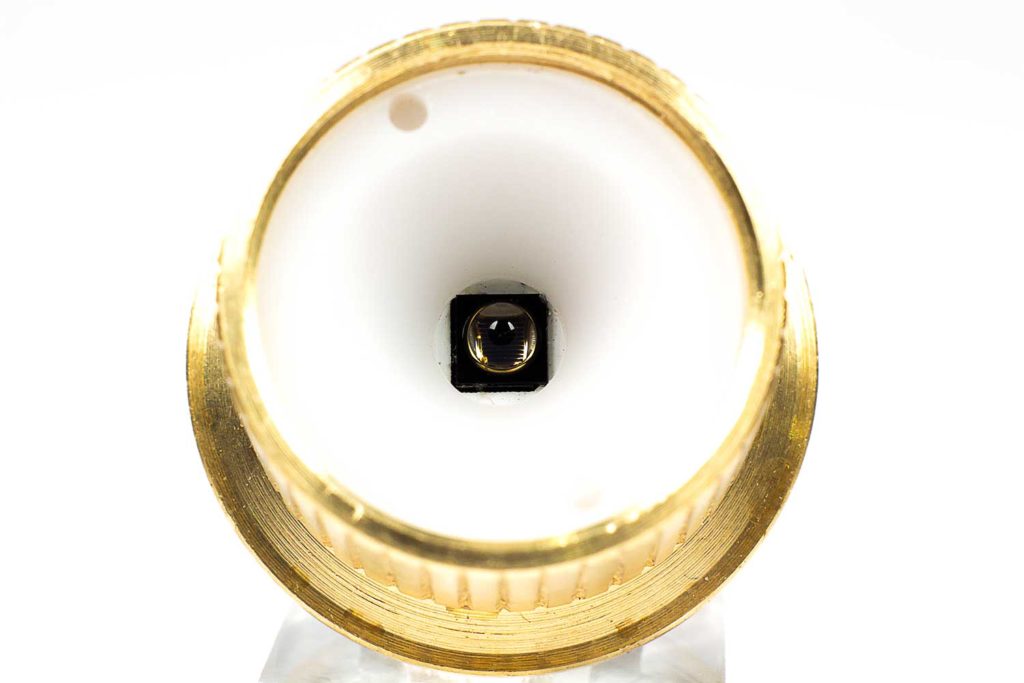
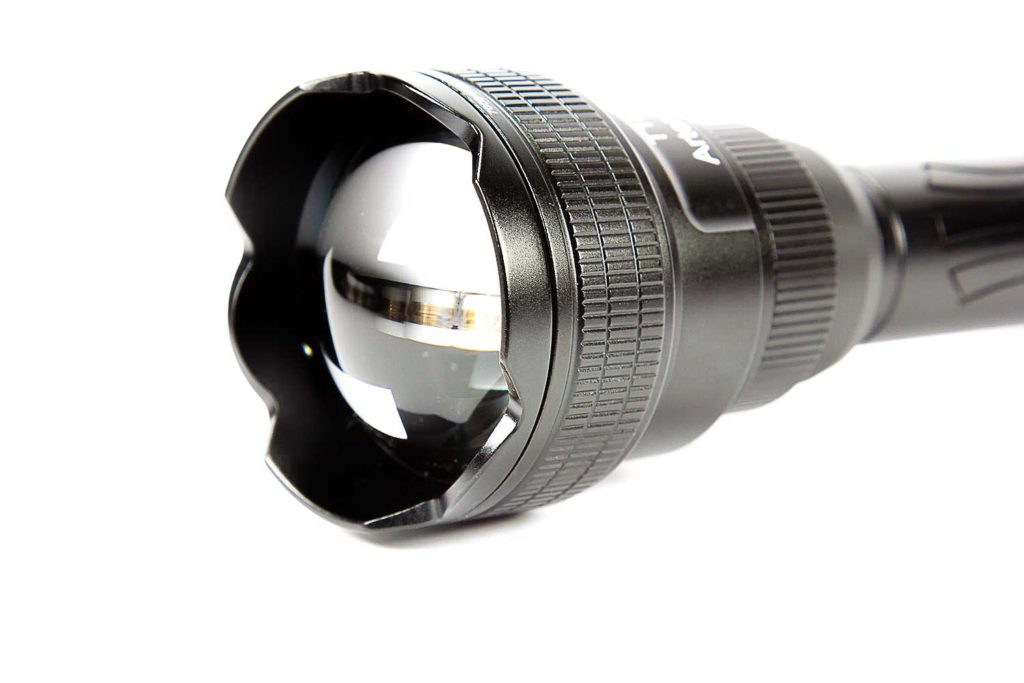
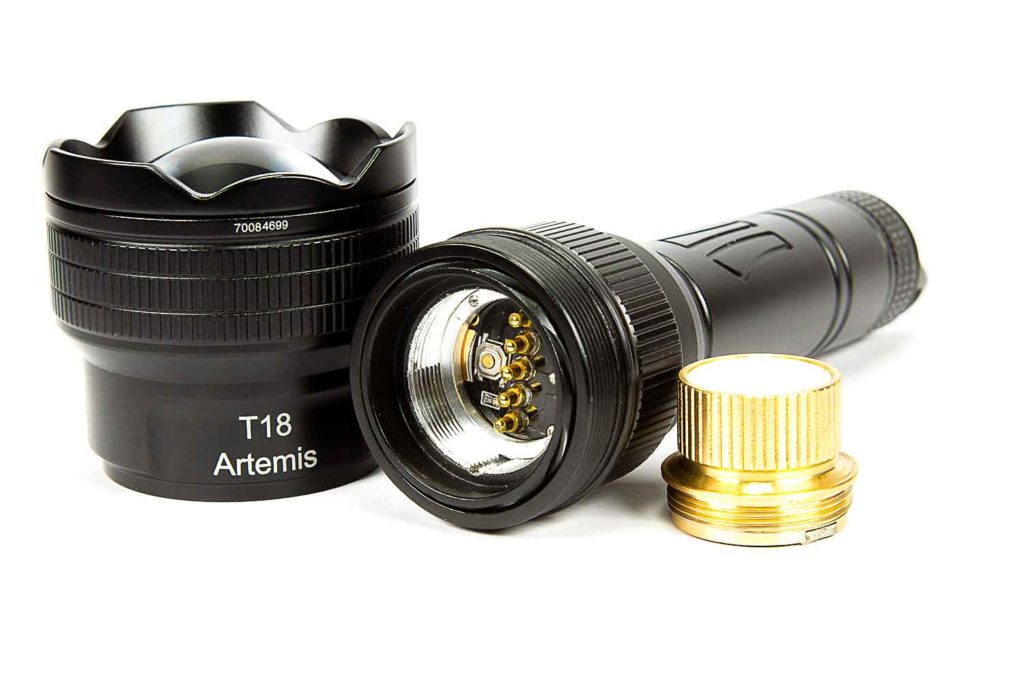
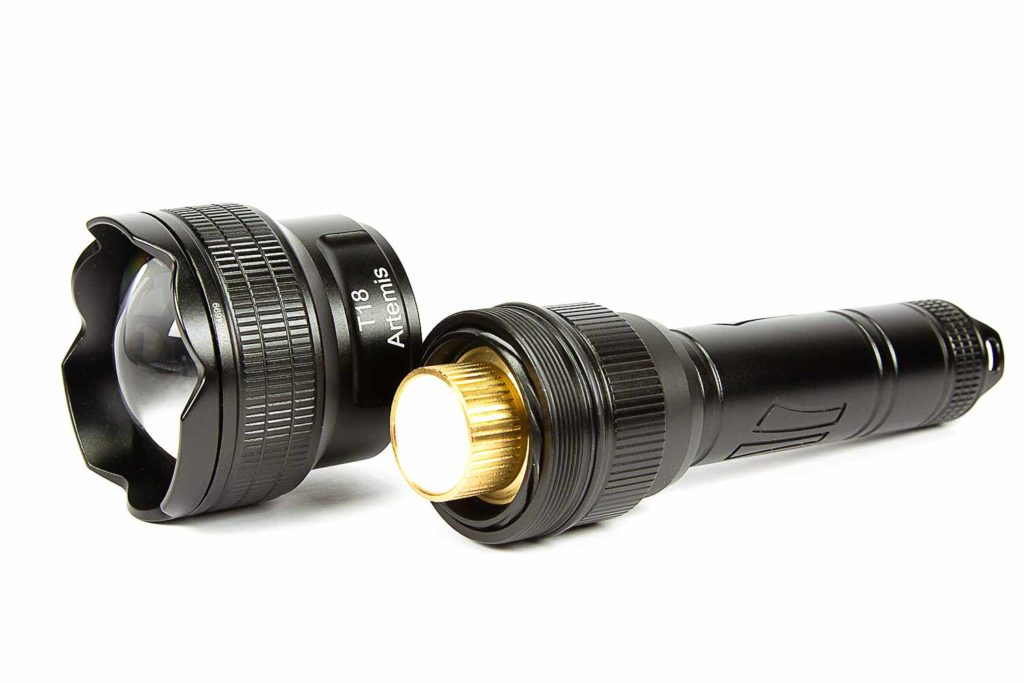
Dimensions
- Length: 65mm (6.5”) in flood, 180mm (7.09”) in spot
- Head diameter: 54mm (2.13”)
- Body diameter: 25.4mm (1”)
Weight:
- Empty: 192.3g (6.78oz)
- With included 21700 cell: 265.8g (9.38oz)
Popular flashlights
Size compared to other popular flashights.
Image 1: Astrolux FT03 mini, Brinyte T18 Artemis.
Image 2: compared to popular throwers: Astrolux FT03, Brinyte T18 Artemis, Lumintop GT Mini.
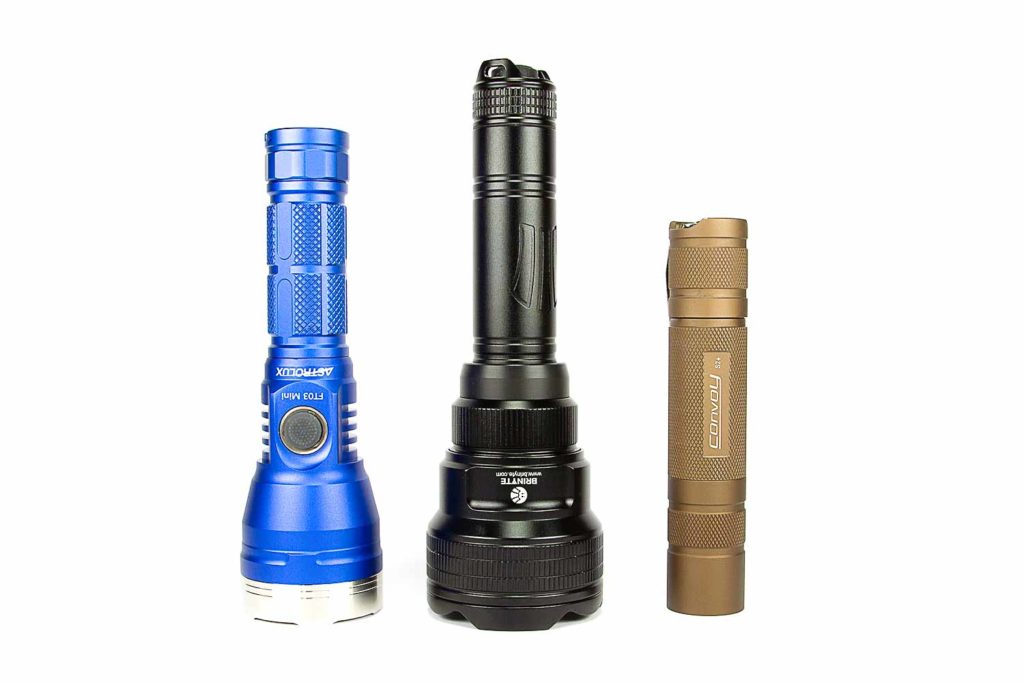
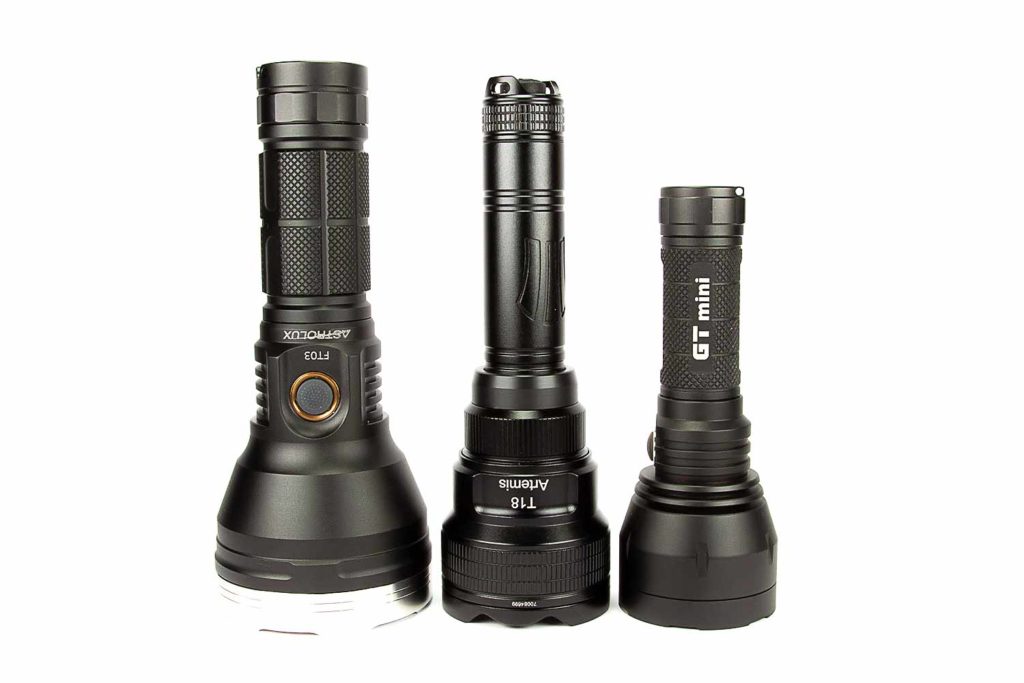
Driver & User Interface:
Each of the “pills” included in the box has its own driver within – this helps make sure that the right forward voltage is applied to the right emitter, so nothing gets cooked. All of them maintain the same UI though, which keeps things nice and simple. Nothing particularly fancy here, but it really doesn’t need to be.
Modes:
From OFF:
- Single click: On
- Half-click: Momentary on
From ON:
- Single click: Off
- Remote +: Brighten
- Remote -: Dim
- Remote “power” symbol: Soft-off – press again to return to last mode
If you choose not to use the remote, it’s a simple on/off switch.
Mode memory:
- As above – if turned “off” with the remote, it will turn back “on” in the same mode if activated by the remote.
Low voltage warning:
- Brinyte mentions that the light has “over-discharge protection” – from testing, that’s in the battery only. On bench power, the light went down to 2.6V and was still on but only very dimly; throwing caution to the wind, I kept winding down the voltage very slowly until at 2.18V, it was completely off – or at least I noticed no difference to my eye when switching to 2.17V. Turning it back on slowly, I got to 2.35V before it kicked on, much brighter than it was at 2.19V (to be expected).
Strobe/blinkies
- N/A
Lock-out mode:
- The threads on the T18 aren’t anodised, so unscrewing the tailcap a little won’t lock it out. Realistically, the switch requires decent activation force and has tabs around it, so that should be sufficient to avoid accidental activation.
PWM
- I can’t see any PWM with my eyes, nor with my camera. Nice!
Batteries & Charging
Included in the T18 Artemis kit is a Brinyte-branded protected 5000mAh 21700 cell with USB-C charging built in. This works both over USB-A to USB-C, and via an Apple 61W power adapter.
Charging this cell with the included USB-A to USB-C cable, I get a charge current of around 1.3A. Popping the cell into my Vapcell S4 Plus on auto mode, I get a rate of 1.5A, so the onboard charging is perfectly suitable for the cell. I personally think it could be higher with no issues, but it’s fine as it is.
18650 cells won’t work in the T18 as the springs won’t make contact at both ends. Unprotected 21700s do fit, but I’m unsure if they’d jostle loose during firing were this attached to a gun – they just don’t feel as solid when you tighten the tailcap.
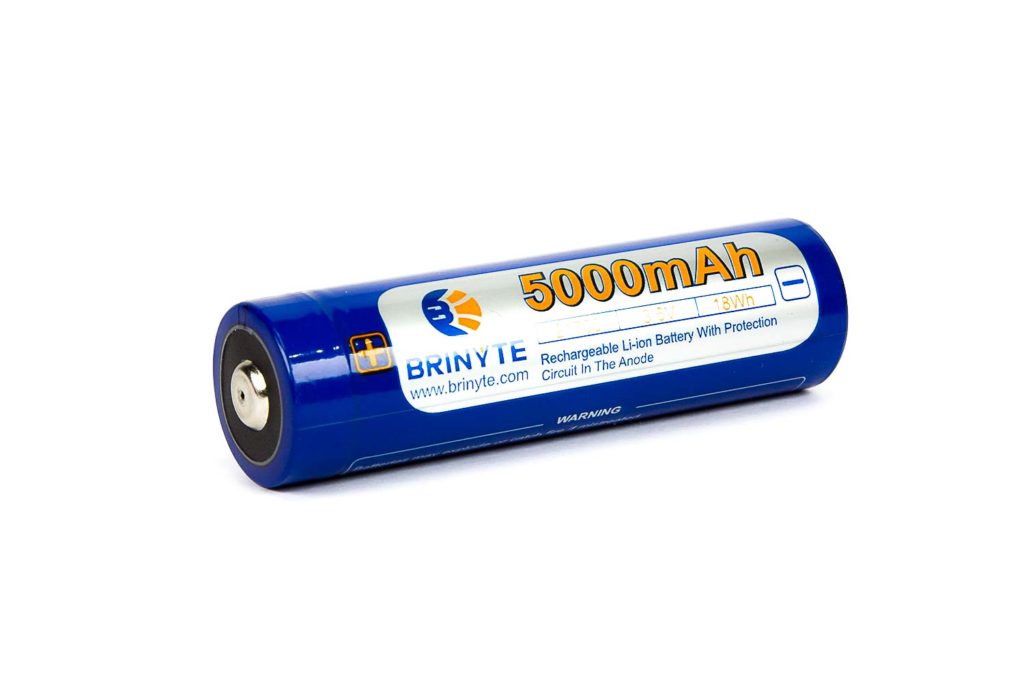
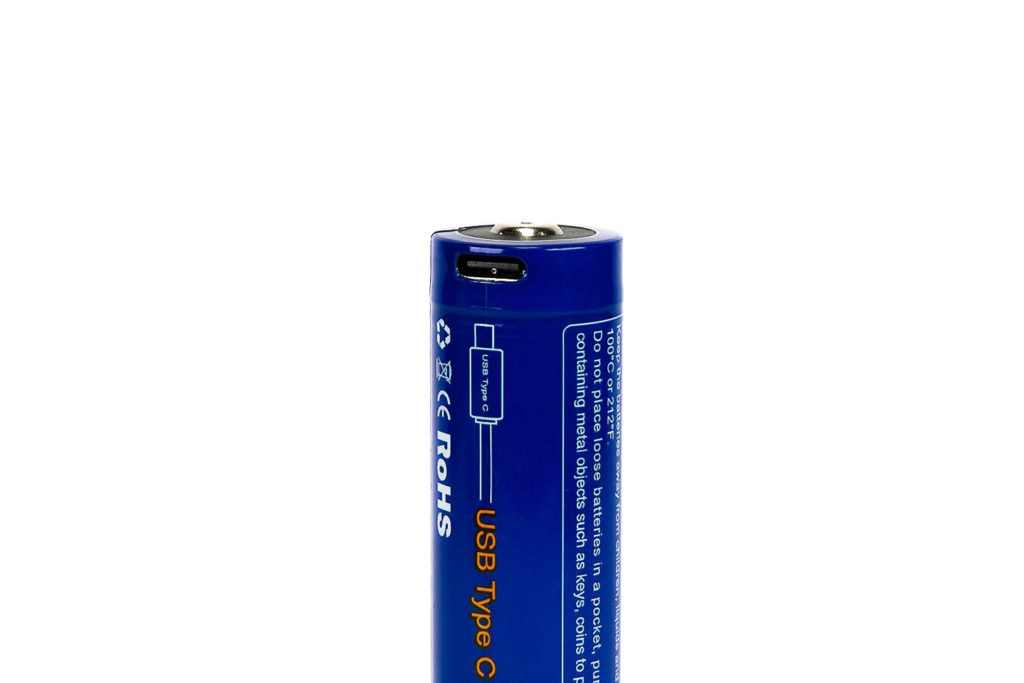
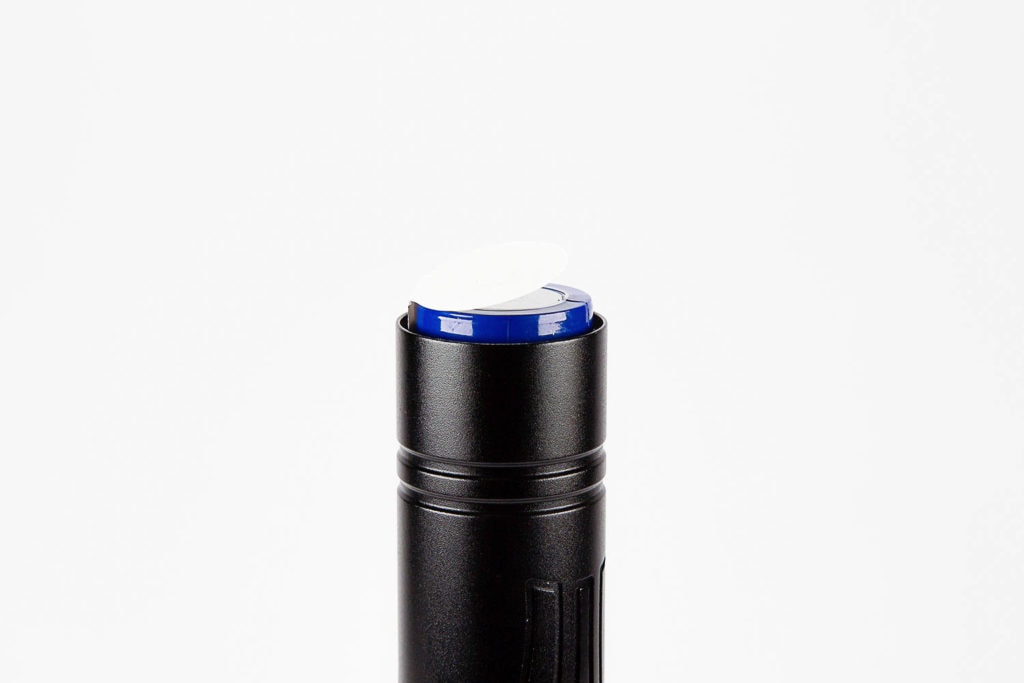
Performance
For my readings, I use the following:
Lux Meter: For lumen readings and runtimes, an Adafruit TSL2591 connected to a Raspberry Pi running Ubuntu, using RuTiTe by bmengineer in a custom sphere (build document coming soon, when I have some more time). A UNI-T UT383S is used for candela readings.
I hope to have temperature readings operational soon, but will need to consider the logistics of connecting a probe to the light without damaging the anodisation.
DMM: Fluke 87 (original series!) and UNI-T UT210E – 16AWG wire is used directly into the Fluke via some banana plugs, and 8AWG wire in a loop for the UNI-T. The DMM I use depends on how high the expected current will be – I use the Fluke for <10A, and the UT210E for >10A.
I will be using the 21700 provided by Brinyte with the T18 for all tests, and recharging in between. Preliminary testing shows me I won’t get any higher results with another cell as they’re regulated current drivers, so let’s stick with 5000mAh.
Amp measurement
Given that this light is primarily a single-mode light and that there’s six emitters in my kit, I’ve opted to do maximum current on each of the emitters, but maximum and minimum on the white, as that’s driven the hardest.
- White:
- Maximum: 2.9 A
- Minimum: 55.6 mA
- Red: 1.11 A
- Green: 1.31 A
- Blue: 1.3 A
- IR: 1.25 A
- UV: 1.275 A
None of these strike me as particularly out-there; I would have liked to have seen the XP-L HI pushed a bit further, but I’m conscious of the heatsinking from the light, as a removable pill setup precludes solid contact to spread the heat.
Runtime graph
Well! When one is handed six emitters, one tests six emitters. A slight issue though – the UV and IR emitters don’t truly conform to “lumens”, as that’s not exactly relevant to those emitters. So, I’ll test four emitters, as I’m somewhat lost as to an effective way to demonstrate longevity on UV and IR.
One thing I found extremely interesting was that between 3 and 6 minutes, all tested emitters showed a similar comparative drop – so while the drivers are separate, there’s clearly shared thermal throttling onboard.
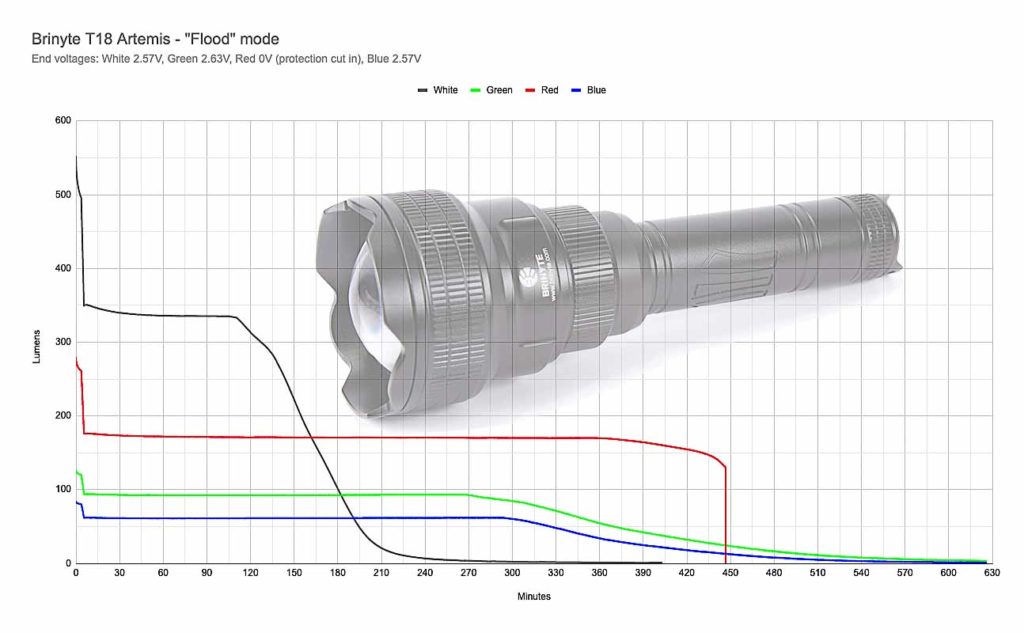
The white runtime is probably the most prominent; after the initial drop, the light holds in the realm of 330-350 lumens for a bit over 90 minutes before slowly ramping down to very dim. I stopped the test a little after 4.5 hours; the light was still on dimly, and the cell when removed measured at 2.57V. I’m a bit concerned that it’s a bit low, though, even with a protection circuit. Basically – when the light’s not really usable anymore, that’s your sign that maybe enough’s enough.
The red runtime however – it held its level for quite some time before dropping a bit and then cutting off at LVP. Impressive!
Green and blue show a similar kind of runtime with the slow fade to nothingness, so I’m glad to see some commonality there.
Lumen measurements (for each mode)
I’ve opted to do lumen measurements in my sphere for the white, and all the colour emitters, in both the “flood” and “throw” ends of the zoom. Colour readings are most likely not exact due to inherent losses in how my sphere might absorb light from those wavelengths; please take them with a grain of salt. They’re purely added in here to show what I measured and for completeness of data, but there’s probably far more accurate ways to measure non-white light.
- White:
- Flood: 556 lm
- Throw: 350 lm
- Red:
- Flood: 273 lm
- Throw: 168 lm
- Green:
- Flood: 126 lm
- Throw: 77 lm
- Blue:
- Flood: 83 lm
- Throw: 50 lm
Throw numbers:
Let’s be honest – this is an outdoors light. I’ll do candela at the usual 5m indoors and 10m outdoors for the four “colour” emitters, at the “throw” setting, but I’d take the indoor readings with a grain of salt.
Now, my outdoor readings are slightly different in that on the night I ran them, it was very cold – shaking hands may have accounted for some differences. For the coloured emitters, I had to rotate the optic back from full extension slightly to get the best result (where the outline of the emitter was sharpest).
- White:
- Indoors (5m): 5587 lux = 139675 cd = 747.46m
- Outdoors (10m): 1442 lux = 144200 cd = 759.47m
- Red:
- Indoors (5m): 2852 lux = 71300 cd = 534.04m
- Outdoors (10m): 708 lux = 70800 cd = 532.17m
- Green:
- Indoors (5m): 2656 lux = 66400 cd = 515.36m
- Outdoors (10m): 685 lux = 68500 cd = 523.45m
- Blue:
- Indoors (5m): 3469 lux = 86725 cd = 588.98m
- Outdoors (10m): 872 lux = 87200 cd = 590.59
These are quite impressive! I’m also very chuffed that I’ve gotten it down to less than 3% variation across the board, despite shaking hands and frozen fingers. Brinyte rates the White at 100kcd or more, Red at 32500cd or more, and Green at 50kcd or more – so they’re all performing above expectations, especially the Red (way to go!).
I’m particularly impressed with the blue though, as on flood mode it appears not quite as bright as green or red (I believe due to the sensitivity of our eyes to deeper blues), but it can definitely hold its own in a candela shootout.
Beamshots
- Indoor:
- Astrolux FT03 SST40 6500K, Brinyte T18 Artemis XP-L HI, Convoy C8 with Osram CSLNM1.TG
- One shot in throw mode, one in flood mode
- Brinyte T18 Artemis XP-L HI, Lumintop GT Mini with SST20
- Astrolux FT03 SST40 6500K, Brinyte T18 Artemis XP-L HI, Convoy C8 with Osram CSLNM1.TG
- Outdoor beamshots are aimed at a tree around 190m away. I’ve adjusted the images so they’re as close to what my eye saw as possible.
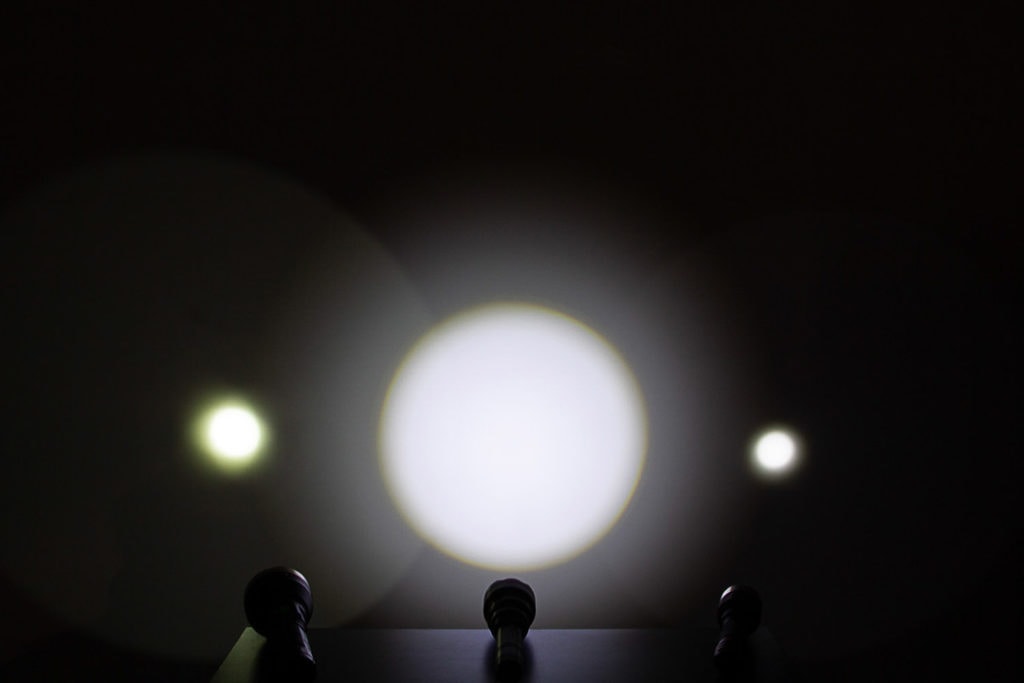
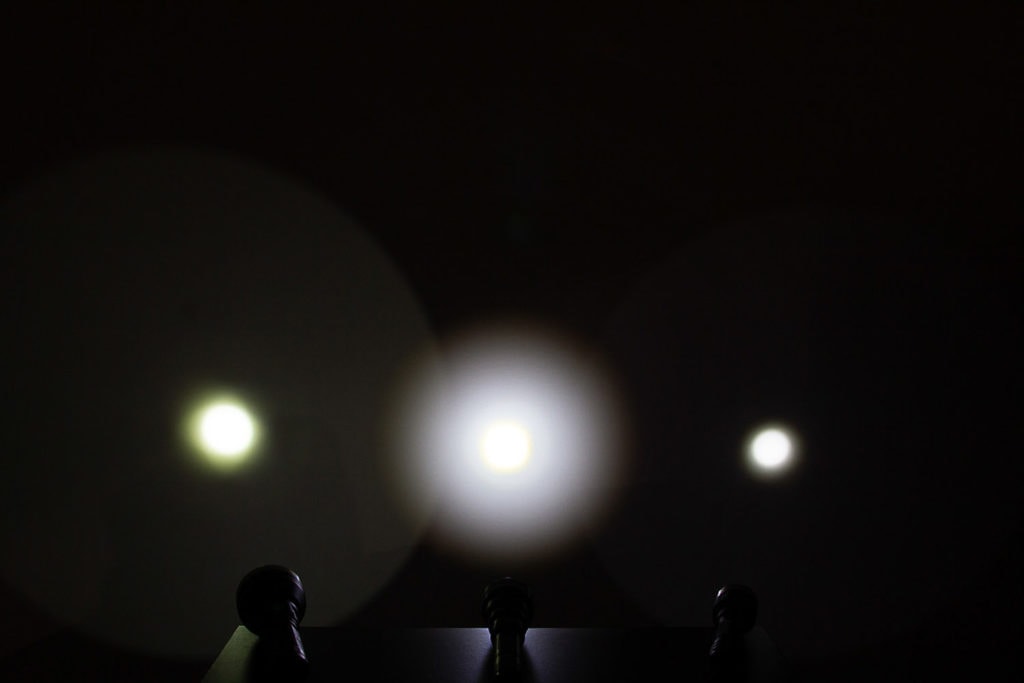
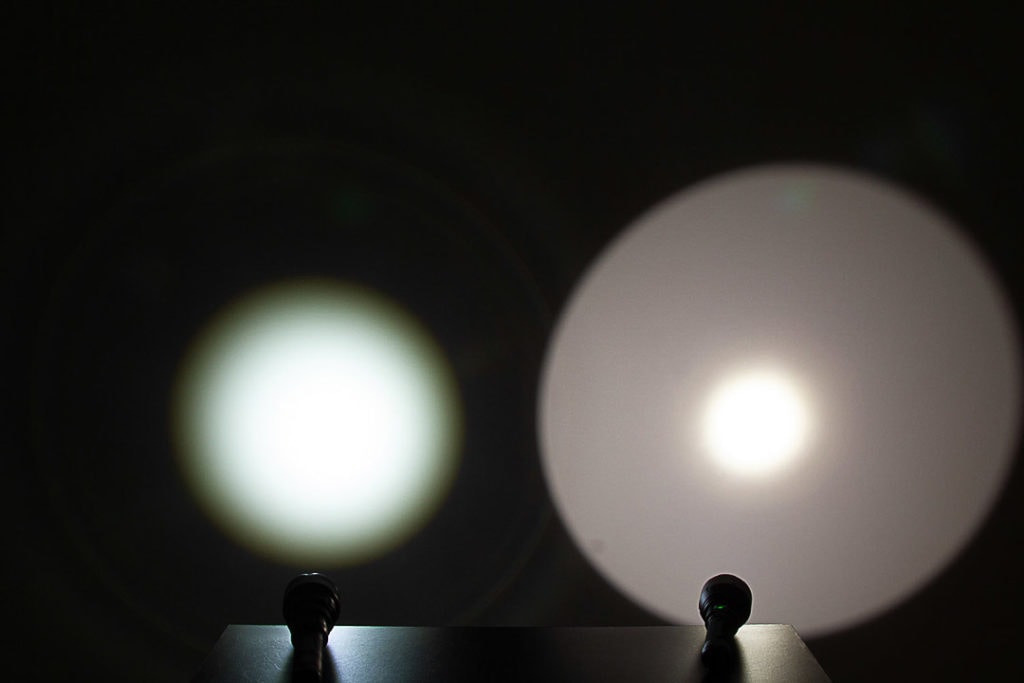
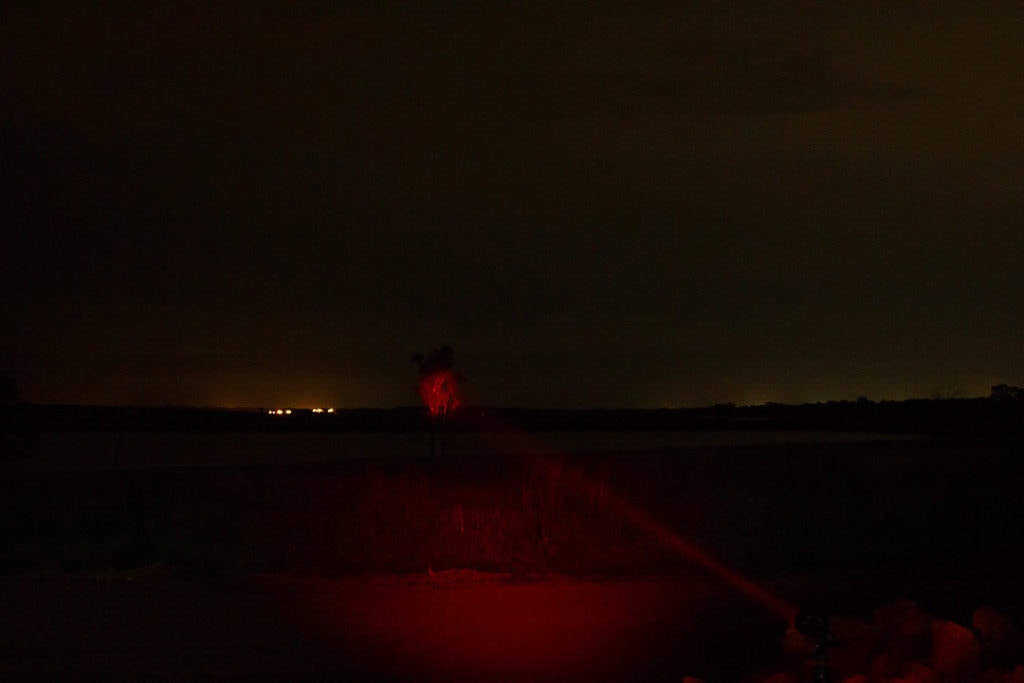
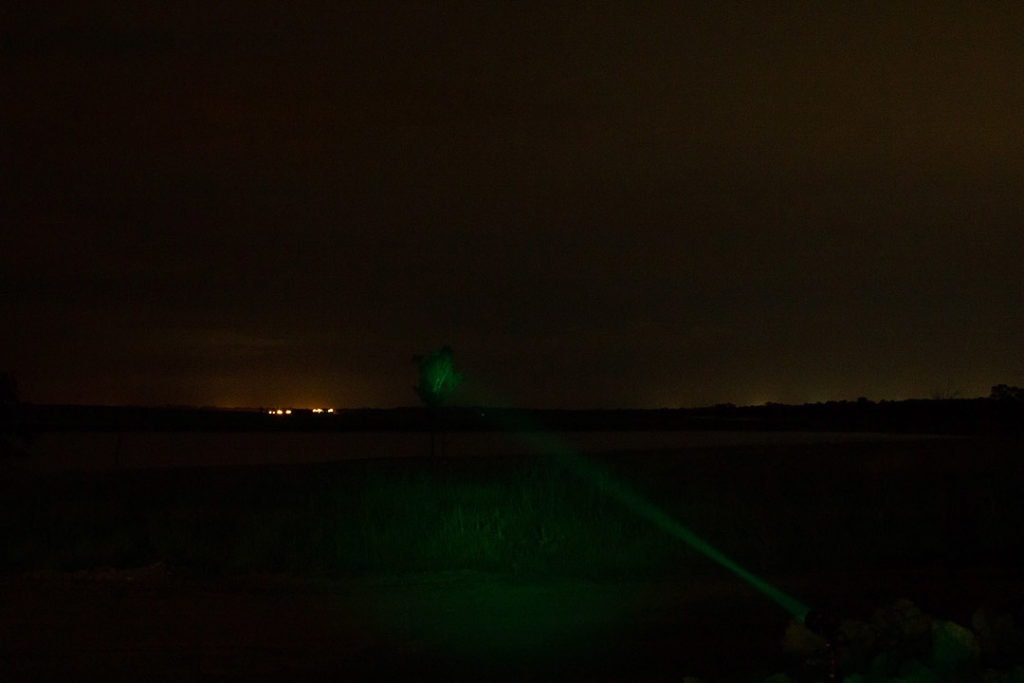
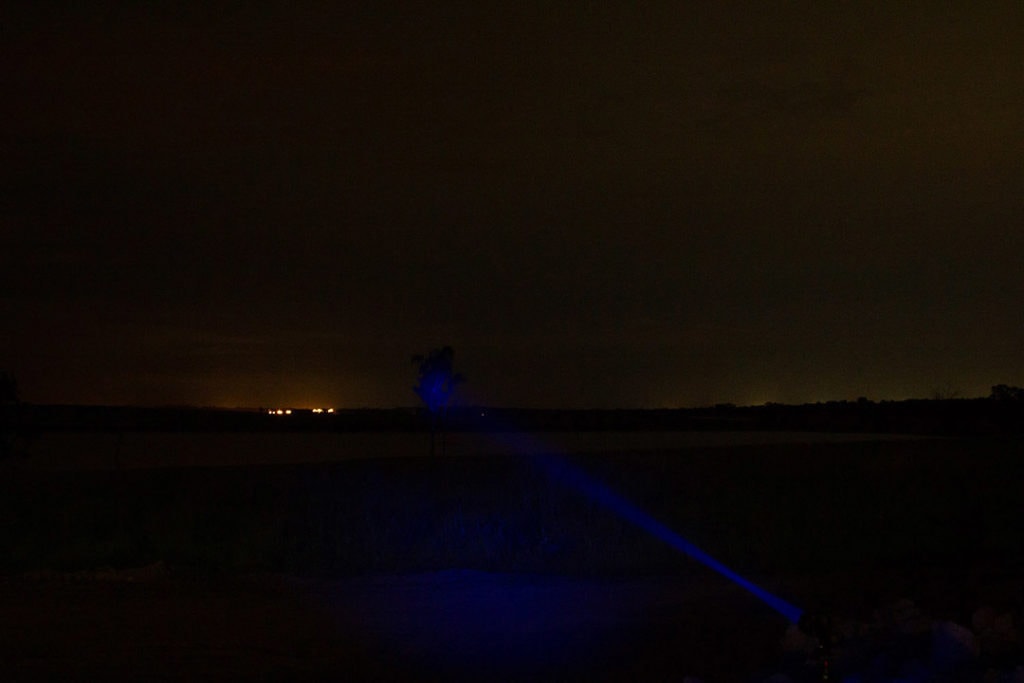

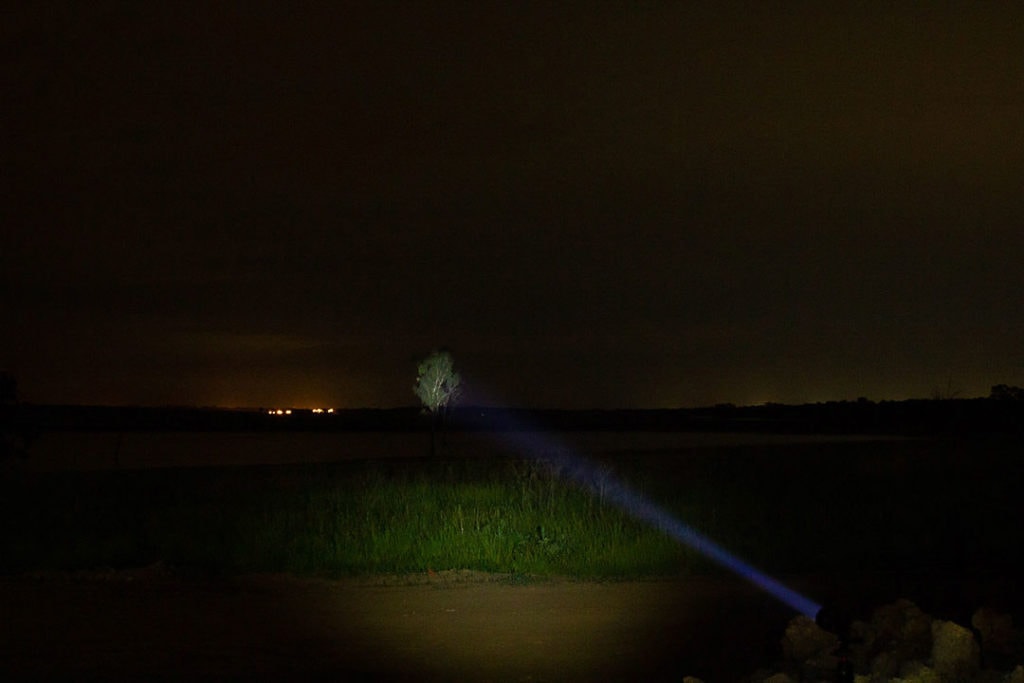
Disclaimer: This flashlight was sent to me for review at no cost, by Brinyte. I have not been paid to review, nor have I been holding back on problems or defects.
OVERALL CONCLUSION
Pros
- Great kit with everything needed
- Fantastic lens gives great clarity
- If nothing else, it’s just fun to play with
Cons
- LVP in battery only (not in light)
- Un-anodised tailcap thread

5 stars: ★★★★★
You know what – I love it. I love that it’s made specifically to have fairly quickly interchangeable emitters, and that there’s such a wide variety of them available for different use cases while hunting depending on prey, or, in my case, just because you want to punch out a beam of a specific pretty colour.
I like that it can be either simple (on/off) or add in a little extra with the remote, if desired; sometimes simple is best.
I’ve had an absolute ball playing with this light from a non-hunter perspective. When I’ve handed it to people I know that do hunt, they’ve seemed quite impressed with the feel and use of it.
This is another one of the times where I’m happy to award a light five stars – this is definitely a light that’s staying in my rotation.
Brinyte T18 Artemis for sale here:
1lumen selects and reviews products personally. We may earn affiliate commissions through our links, which help support our testing.